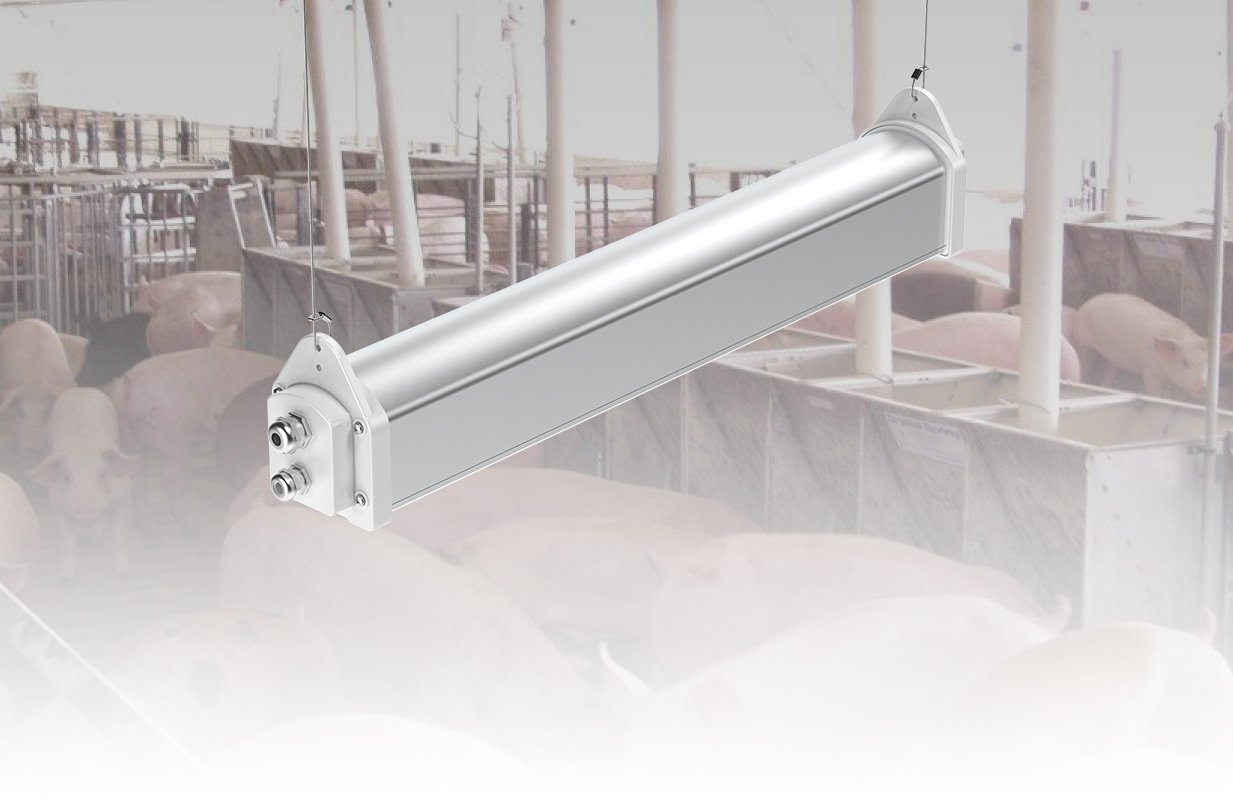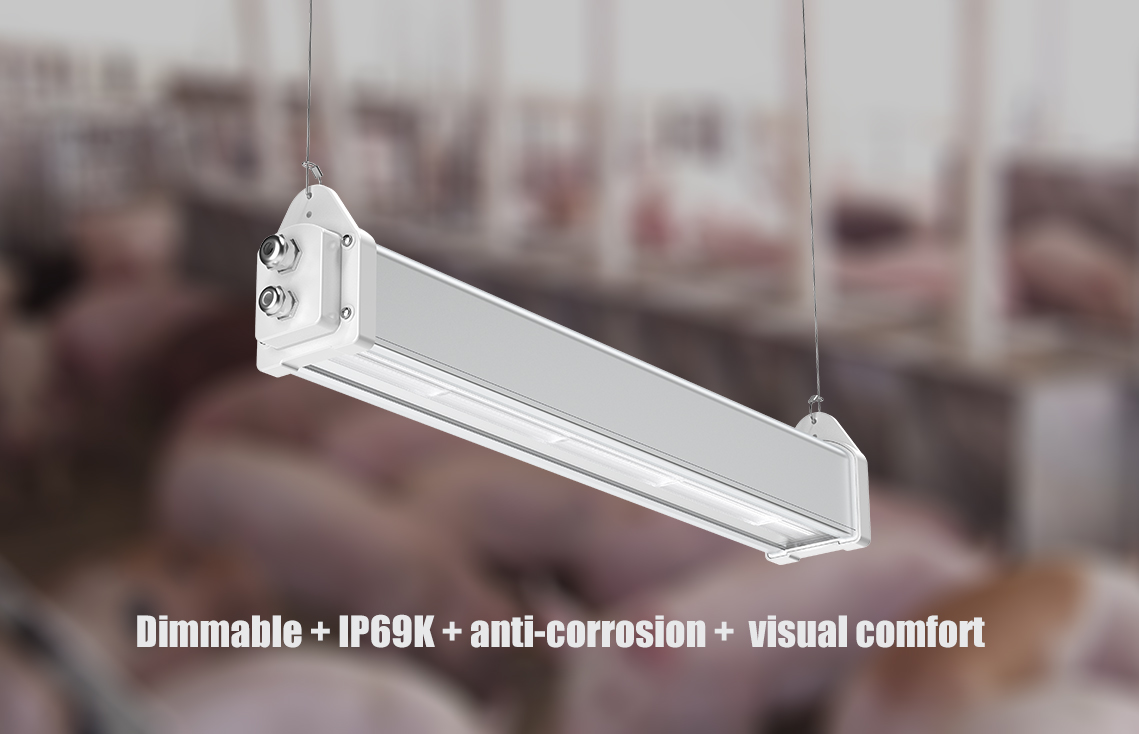The lighting environment of pig farms has no small effect on the productive efficiency of pig industry. Because the light environment can directly or indirectly affect the production performance of pigs. The modern pig industry mostly adopts the closed or semi-closed breeding mode. This kind of breeding mode will lead to the change of lighting environment, destroy the animal biological rhythm, affect the healthy growth of pig populations, and then affect the economic efficiency of pig farm. So it is important to choose proper light for pig farm .

The livestock industry including pig breeding is gradually entering the era of smart farm. How to further explore productivity by improving environmental parameters has become the research direction of livestock industry today. The influence of light is one of the research directions of scientific breeding. Whether the lighting environment is good or not is related to the healthy growth of the pig population and the production efficiency of the whole pig farm. The lighting design for pig farms is a thing that require skills. There are a lot of things to think about when you design. Different purposes of production require different treatment.
Lighting requirements of pig farm
In pig farms, classification management may be carried out according to the different physiological periods of pigs. Pigs of different physiological status need different growing environment. Such classification management is helpful to the accurate regulation of the growing environment of each zone in pig farms. Commonly, pig farms are divided into the following zones: male pig zone, back-up zone, pregnancy zone, farrowing zone, nursery zone, fattening zone. The physiological performance of pig populations expected by the holder is different in different zones. Therefore, lighting requirements vary from zone to zone.
The light environment of piggery is mainly composed of light intensity and light time. So generally the light supply mechanism is also determined from these two dimensions
In male pig zone:
Providing appropriate lighting levels to male pig zone can significantly increase sperm concentration and ejaculation in boars. Prolonging photoperiod can also increase the sexual activity of boars.
In back-up zone:
Proper lighting can allow the pigs in back-up zone to grow and develop rapidly and reach sexual maturity 30 to 45 days earlier.
In pregnancy zone:
In pregnancy zone,proper lighting can help increase the litter size of sows and can affect the growth of piglets after they give birth.
In farrowing zone:
In farrowing zone, increasing the illumination intensity and extending the illumination time can stimulate the secretion of prolactin. Therefore, the frequency of lactation and the lactigenous volume of sows increased significantly ,which also increased the weaning weight of piglets.
In nursery zone:
Providing proper light to piglets in the nursery zone can reduce piglet morbidity, improve piglet survival rate and increase daily weight gain.
In fattening zone:
As for the light of fattening zone, it is enough as long as it does not affect the feeding of pigs and it is convenient for the management operations . Strong light will affect the rest and sleep of the fattening pigs.
Actually, too high or too low a level of light will have more or less impact on the state of pigs. In addition to gaining expected physiological performance, enhancing physique, and reducing morbidity,moderate illumination level also can improve the recognition rate of food, increase the evenness of food intake, achieve positive feed conversion. However, unstable lighting levels may lead them to nervous and abnormal behavior-screaming, panic, and even aggressive behavior.
So stable light level is important, especially for semi-closed pig farms that are partly dependent on natural light. A steady level of light must be achieved to ensure a stable state of pig populations. The fattening zone is a very important zone and the main profit source of pig farm. Other breeding zones all are working for the fattening zone. Therefore, the growing environment of the pig population in this area deserves special attention.
How to keep a stable lighting level in fattening zone when there is an unstable external light environment (maybe because of sun raise and sun set, changeable weather conditions, alternating seasons ) so as not to cause the pig abnormal reaction is what pig farmers should solve emphatically. LHB19 LED linear light come with excellent features that can be used in pig farm.

How to choose the right LED light for pig farm
1) stable lighting level
LHB19 LED linear light with daylight sensor can well adjust the lighting level according to the change of exterior light intensity. During the day, when the light intensity is relatively high, LHB19 LED linear light will automatically dim down to the standard value of overall light environment. At night there will be no natural light , and the lighting fittings will also heighten brightness to corresponding level. Of course, all of these should follow the scientific guidelines of pigsty lighting - reasonable light intensity and light time.
2) IP69K protection level
The cleaning of pigsty is a matter that cannot be ignored. Keeping the pig house clean and hygienic can effectively reduce the rate of pig disease. Normally, pig farmers will monthly carry out the washing and cleaning of the pigsty regularly. This will inevitably involve the use of water cannon and other washing equipment. Although cleaning will not necessarily shoot toward the light fixture, a light fixture with a good level of protection IP69K can effectively prevent contingencies.
3) high anti-corrosion level
The reason why the anti-corrosion performance of pigsty lights is emphasized is that in addition to the manure and urine produced by the pigs may cause corrosion to the metal shell of the lamps, the disinfectant used in the regular monthly disinfection work will also corrode the lamps. So the lamps used in the pigsty should have corrosion resistance character. LHB19 LED linear light is a kind of lamps with good corrosion resistance.
4) low glare level
Human have three kinds of cones in their retinas, so human’s trichromatic light sense enables them to distinguish most colors on the spectrum. Pigs, like most mammals, are bichromatic. They are less able to distinguish between colors. One of the characteristics of bichromatic light sense vision is that they are very sensitive to glare, that is, they have a strong resistance behavior to moving from the light comfort zone to the high-light stimulation zone. This will lead to a series of actions like retreat, move, walk around to try to avoid the glare. So light fixtures in pigsties should be low glare. This can ensure the emotional stability of pigs and reduce the abnormal behavior of pigs.












